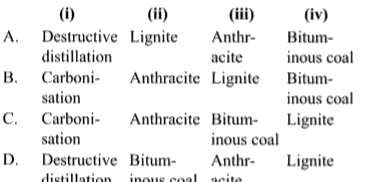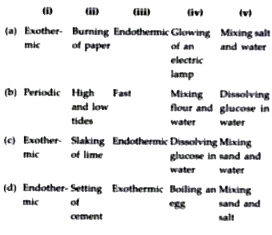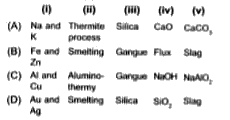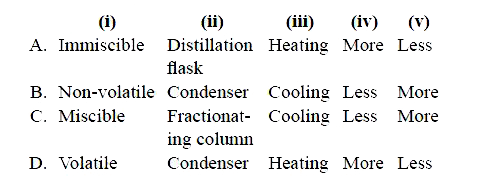Read the given passage and fill in the blanks by choosing an appropriate option.
The process of conversion of wood into coal is called __(i)___ There are three main varieties of coal w hich vary in their carbon content __(ii)_ has upto 96 % of carbon, ____(iii)_____ has about 65 % of carbon while J.i.Yl._ has about 38 % of carbon.

The correct Answer is:C
(i) is carbonisation, (ii) is anthracite, (iii) is bituminous coal and (iv) is lignite.
Topper's Solved these Questions
- NSO QUESTION PAPER 2017-18 SET-ABOOK - SCIENCE OLYMPIAD FOUNDATION CHAPTER - NSO QUESTION PAPER 2017-18 SET-AEXERCISE - ACHIEVERS SECTION
3 Videos
- NSO MODEL TEST PAPER -1BOOK - SCIENCE OLYMPIAD FOUNDATION CHAPTER - NSO MODEL TEST PAPER -1EXERCISE - ACHIEVERS SECTION
2 Videos
- NSO QUESTION PAPER 2017-18 SET-BBOOK - SCIENCE OLYMPIAD FOUNDATION CHAPTER - NSO QUESTION PAPER 2017-18 SET-BEXERCISE - ACHIEVERS SECTION
3 Videos
Similar Questions
Read the given passage and fill in the blanks by choosing an appropriate option.
Metals have high densities except (i)__ which can even float on water. Metals are malleable and ductile (ii)___ are the most malleable and ductile metals. All metals conduct heat and electricity. (iii)___ is the best conductor while (iv)___ is a poor conductor.

View SolutionRead the given passage and fill in the blanks by choosing an appropriate option. There are some changes in which heat from outside is absorbed leaving the surroundings cooler while in other changes heat is given out making the surroundings warmer. A change in which heat is given out is called a/an i______ change e.g., ii______ , while a change in which heat is taken in is called a/an iii______ change e.g., iv______ . There are many changes in which heat is neither given out nor taken in e.g., v______ .

View Solution
Knowledge Check
Which variety of coal has highest percentage of carbon?
ABituminousBAnthraciteCPeatDLigniteRead the given passage and fill in the blanks by choosing an appropriate option. When a mixture of two_(i)___ liquids having a difference of 25∘C in their boiling points is to be separated, a _(ii)____ is used which increases the ___(iii)___ surface area. As a result, when the vapours of both the liquids rise, the ___(iv)_volatile liquid will condense while the vapours of_(v)__ volatile liquid will rise.
A(i)(ii)(iii)(iv)(v)ImmiscibleDistillation flaskHeatingMoreLessB(i)(ii)(iii)(iv)(v)Non volatile condensercoolingLess MoreC(i)(ii)(iii)(iv)(v)Miscible fractionating column coolingLess MoreD(i)(ii)(iii)(iv)(v)volatile Condenser Heating More LessRead the given passage carefully and fill in the blanks by selecting an appropriate option.
Oxides of (i) –––––– are reduced to their respective metals by heating with coke and the process is called (ii) –––––––. Before carrying out reduction with carbon, if the calcined or roasted ore still contains infusible impurities of earthy matter, called (iii) ––––––––, an additional substance, called (iv) –––––––– is added which combines with (iii) to form a fusible material, called (v) –––––––. AABBCCDD
AABBCCDD
Read the given passage and fill in the blanks by choosing an appropriate option.
When a mixture of two (i) –––––––– liquids having a difference of 25∘C in their boiling points is to be separated, a (ii) –––––––– is used which increases the (iii) ––––––––– surface area. As a result, when the vapours of both the liquids rise, the (iv) –––––––––– volatile liquid will condense while the vapours of (v) –––––––– volatile liquid will rise.

View SolutionA few reactions are listed below:
I. Hydrogen + Oxygen → Water II. Calcium oxide + Carbon dioxide → Calcium carbonate III. Silver nitrate + Copper → Copper nitrate + Silver IV. Sodium hydroxide + Hydrochloric acid → Sodium chloride + Water V. Sodium nitrate → Sodium nitrite + Oxygen
Now, read the given passage and fill in the blanks by selecting an appropriate option. Reaction(s) ___(i) is/are combination reaction(s), reaction(s) ____(ii) is/are single displacement reaction(s), while reaction____(iii) is a decomposition reaction. Reaction(s)____ (iv) is/are neutralisation reaction(s) and heat energy is ____(v) in this/these reaction(s).

View SolutionComplete the following paragraph by filling in the blanks (i) to (v) with appropriate words:
(i) __________ make up about 80% of the animal kingdom. Their bodies have a hard, outer covering or exoskeleton made up of a proteinaceous substance called (ii) ________ The body is divided into a (iii) __________ thorax, and (iv) _______ It also bears multiple pairs of jointed legs. Arthropods also have antennae and (v) ________ on their heads.
View SolutionBased on reading of the passage given below, answer the next two questions by selecting the most appropriate option.
Archaeologists have given lengthy names for the time that we are studying. They call the earliest period the Palaeolithic.
This comes from two Greek words, 'palaeo', means old and 'lithos', means stone. The name points to the importance of finds of stone tools. The Palaeolithic period extends from 2 million years ago to about 12000 years ago. This long stretch of time is divided into the Lower, Middle and Upper Palaeolithic, 4
This long span of time covers 99% of human history.
The period when we find environmental changes, beginning about 12000 years ago till about 10000 years ago is called the Mesolithic (middle stone).
Stone tools found during this period are generally tiny and are called microliths. Microliths were probably stuck on to handles of bone or wood to make tools such as saws and sickles. At the same time, older varieties of tools continued to be in use.
Which one of the following statements true about pre-historic period?
View SolutionBased on reading of the passage given below, answer the next two questions by selecting the most appropriate option.
Archaeologists have given lengthy names for the time that we are studying. They call the earliest period the Palaeolithic.
This comes from two Greek words, 'palaeo', means old and 'lithos', means stone. The name points to the importance of finds of stone tools. The Palaeolithic period extends from 2 million years ago to about 12000 years ago. This long stretch of time is divided into the Lower, Middle and Upper Palaeolithic, 4
This long span of time covers 99% of human history.
The period when we find environmental changes, beginning about 12000 years ago till about 10000 years ago is called the Mesolithic (middle stone).
Stone tools found during this period are generally tiny and are called microliths. Microliths were probably stuck on to handles of bone or wood to make tools such as saws and sickles. At the same time, older varieties of tools continued to be in use.
Which one of the following statements regarding pre-historic period is untrue based on the passage?
View Solution
